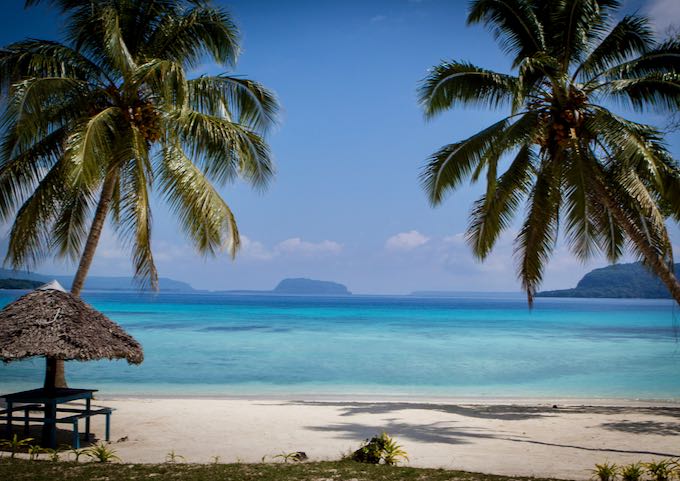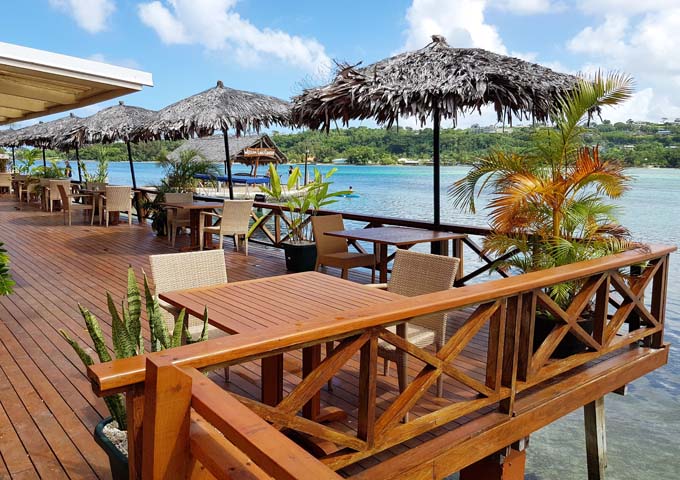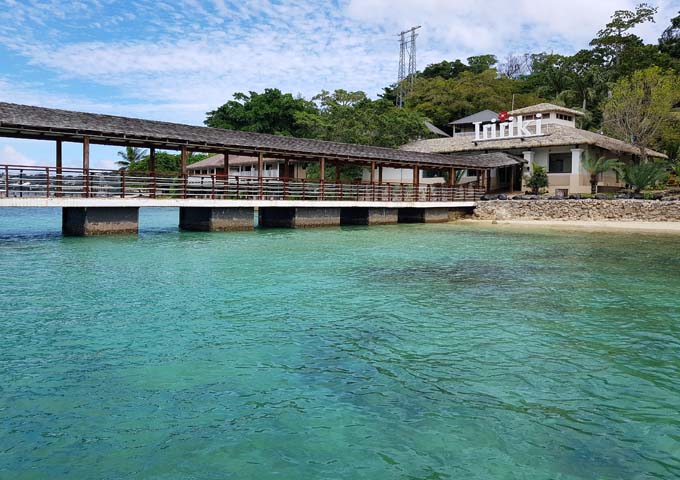SD › Vanuatu Best Places
Updated: September 16, 2020
By Santorini Dave
The Best Places to Stay in Vanuatu

Best Region for Diving & Snorkeling: Espiritu Santo Island
Not as scruffy and undeveloped as Fiji and Tonga, or as modern and expensive as New Caledonia and Tahiti, Vanuatu is an affordable, accessible, and authentic slice of Melanesia. Across the Y-shaped archipelago of 83 islands among 6 provinces is everything expected in a slice of Pacific paradise: deserted beaches, world-class snorkeling and diving, and amiable villages. But Vanuatu can also boast other attractions rarely, or never, found elsewhere in the region: activate volcanoes with lava-slurping craters reached on foot, caves heaving with bats, tribal settlements that practiced cannibalism not that long ago, shipwrecks (including the world’s largest and most accessible), rainforests scattered with waterfalls, and plantations of premium coffee.
Facing a scenic bay sprinkled with islets, the compact and likeable capital, Port Vila, provides a surprisingly broad range of places to stay and eat, some with a definite French flavor. Along the single main street and the seaside pathway offering agreeable water views are the produce and handicraft markets, and the majority of Vanuatu’s tourist facilities, including the country’s only mall (so far). Elsewhere around the main island of Efate are affable villages and serviceable beaches with a few resorts attached in areas like Pango, Eratap, Erakor, and Havannah.
Considerably less developed is Espiritu Santo, Vanuatu’s largest island. Northwest of Efate, it attracts those seeking adventure (e.g. hiking around lofty mountains and world-class diving among WWII shipwrecks), or something more sedate (e.g. postcard-perfect beaches). To the far south, Tanna Island constantly surprises, with an active volcano accessible on foot, hot springs, coffee plantations, rainforests, waterfalls, and empty beaches alternating between white and black sands.
Vanuatu’s second-biggest island, Malekula is rugged, remote, and undeveloped, with a lack of infrastructure and dearth of tourists ensuring that villages maintain centuries-old customs. Other far-flung islands include Ambrym, with sparsely-populated villages clinging to slopes of growling volcanoes; and Pentecost, renowned for the traditional bungee-jumping-style ceremonies celebrating the harvest of the essential crop: yam (like a sweet potato).
Vanuatu suffered a catastrophe when Severe Tropical Cyclone Pam, the region’s second-worst ever, swept across the islands in 2015. Many village homes and crops, particularly across the southern islands, including Efate, were destroyed by winds of up to 280km per hour. Although a few resorts have yet to recover (and may never do so), most of Vanuatu and its tourism industry are now back on their feet.
The Best Places to Stay in Vanuatu

Erakor Island Resort & Spa on Erakor Island, Port Vila.
- Best Luxury Hotels in Vanuatu
Erakor Island Resort & Spa • Hideaway Island Resort & Marine Sanctuary • Iririki Island Resort & Spa Vanuatu - Best Boutique Hotels in Vanuatu
Mangoes Resort • Paradise Cove Resort • CoCo Beach Resort - Best Budget Hotels in Vanuatu
Seachange Lodge • Coconut Palms Resort • Golden Port Hotel
- Best Region for Beaches: Tanna Island
To the far south, Tanna is understandably popular for its adventure activities, remarkable landscapes, and especially, dazzling beaches. Think deserted coves of angled palms and turquoise lagoons buffered by colorful reefs. Along the mid-west coast, the finest beaches of snow-white sand are predictably commandeered by upmarket resorts. Most beaches to the south and east, particularly around the omnipotent Mount Yasur volcano, are black. These may not be as photogenic, but the sand is still powdery, the water is especially inviting, and the volcanic backdrop is extraordinary. - Best Region for Diving & Snorkeling: Espiritu Santo Island
The underwater delights around the island of Espiritu Santo, and especially, the capital Luganville, are so outstanding that some visitors spend most of their days below the sea and nowhere else. The marine life is abundant, reefs almost luminescent, and unusually for the general region, there are shipwrecks. SS President Coolidge is regarded as the world’s largest and most accessible wreck, and easy to reach with just a snorkel and fin. Divers also flock to Million Dollar Point, a sunken junkyard of trucks and other WWII debris. Local operators can escort divers around the wrecks, reefs, and caves during the day or night, while snorkelers will also relish the crystal-clear freshwater pools at Blue Holes. - Best Region for Adventure: Tanna Island
For those with the time and energy, this petite island to the south seems to have it all: isolated villages practicing bizarre traditions, diving through submerged caves, trekking among rainforests sprinkled with waterfalls, and wild horses roaming across wild plains. And the crème de la crème is Mount Yasur, regarded as the most accessible active volcano in the world. Visitors can be driven within a 10-minute walk of the crater lip, and watch open-mouthed as lava slurps and rocks hurl into the sky. This is almost unique: such proximity would not be allowed for safety reasons almost anywhere else on the planet. - Best Region for Boating: Port Resolution, Tanna Island
Among yachties, Vanuatu isn’t as renowned as Tonga, with its reliable winds, or Tahiti, with its developed harbors lined with appealing bars. On Vanuatu’s loveliest island is the extraordinary harbor, Port Resolution. Located in a U-shaped cove on the eastern tip, the setting is striking, with cliffs and waters dominated by the rumbling Mount Yasur volcano. The harbor is deep and close to popular beaches, but there isn’t much in the way of facilities. But yachties do appreciate its convenience, allowing easy exploration around the rest of Vanuatu to the north, New Caledonia to the south, and Fiji across to the east. - Best Region for Shopping: Port Vila
Not surprisingly, the capital offers the most variety and quality of places to spend money, with the only place (so far) in the whole country that could be called a mall: Tana Russet Plaza. The Vila Outdoor Market, also known as Mama’s Market, is just as imagined: scruffy, sizeable, and fascinating, with all sorts of tropical fruits and vegetables in an undercover and central position. A few handicraft stalls are dotted around the market; otherwise, shopaholics may want to catch a minibus to the Handicraft Market south of the town center. Pleasingly, almost everything in the capital is spread along 1 main street parallel to the harbor, so shopping is easy and breezy. - Best Region for Food & Restaurants: Port Vila
The capital is compact, with almost everything along 1 main thoroughfare beside the pretty harbor. Among numerous places selling unhealthy fried foods are many inviting eateries: from casual western-style bistros, as popular for Wi-Fi as for the wraps and pizzas, to French-style cafés serving crêpes, baguettes, and croissants. Vanuatu is probably the least multicultural island nation in the South Pacific, but it is still possible to find authentic restaurants offering Chinese, Thai, and of course, French cuisine. And don’t forget to try some traditional food, such as coconut crab and lap lap (grated sweet potato). - Best Region for Families: Erakor and Eratap, Efate Island
Unlike Tahiti and Fiji, Vanuatu is not crammed with family-friendly resorts offering kids’ clubs, packaged deals, and playgrounds. Staying on the main island of Efate avoids expensive inter-island flights, and inevitably, extended airport waits. Erakor and Eratap are adjoining peninsulas not far east of Port Vila. Lovely mid-range resorts face lagoons (which resemble rivers), while a few feature narrow artificial beaches more agreeable for kayaking and snorkeling than swimming. Erakor is only a 10-minute trip from the capital by public minibus, while Eratap is a tad more isolated: only accessible by chartered minibus, or those provided by the resorts. - Best Region for Nightlife: Port Vila
Nightlife is certainly not a major attraction, but there are a few things to do after dark in the capital. Families can enjoy a movie at the country’s only cinema in the Tana Russet Plaza, or free showings in cafés, such as Nambawan. A few resorts offer traditional shows, sometimes including fire and dance. Some visitors will be happy enough slurping coffee in Mediterranean-style waterside cafés, sipping cocktails in beach resorts, or trying to beat the odds in one of the casinos. But after the sun has firmly set, many of the trendier locals and tourists flock to nightclubs that offer hip DJs and colorful cocktails – and even the chance to also dip in the pool or harbor. - Best Region for Vibe & Culture: Malekula Island
The second-largest island is also one of the least developed. As visitors flock to Tanna for the adventure, and Espiritu Santo for the beaches, Malekula seems to be forgotten. The scarcity of tourists and rugged terrain ensure that villages remain more authentic (but no less friendly), often still practicing traditions that haven’t changed for hundreds of years. Most locals are divided into 2 rival tribes (named after the penis sheaths they wear), with both tribes engaging in unique ceremonies involving magic, trances, fire-walking, and body-painting. With cannibalism completely abolished only a few decades ago, tourists can also visit gruesome burial sites. - Best Region for Romantic Holidays: Havannah, Efate Island
Unlike Fiji and Tahiti, Vanuatu hasn’t really embraced the burgeoning market for honeymoons and romantic getaways. Very few resorts offer intimate over-the-water bungalows but several, even in the suburbs of Port Vila, do provide secluded villas with private pools. One of Vanuatu’s finest destinations for a romantic holiday is The Havannah. This award-wining adults-only resort along the scenic bay of the same name is only 30km from the capital, home to numerous facilities and the airport. Havannah bay is also the departure point for day trips to the idyllic islands of Lelepa and Moso just offshore.
The Best Regions in Vanuatu for Tourists

Iririki Island Resort & Spa off Port Vila.
Port Vila – Town Center
Far more appealing than the capitals of Fiji and Tonga, but not as classy as Noumea, Port Vila is likeably laid-back, and offers much of the country’s facilities. Facing a scenic harbor, with headlands and islands, the town is most photogenic from along the seaside pathway. The 1 main street seems to be permanently clogged with vehicles, but still enjoyable to walk along. Attractions include cafés, casinos and nightclubs, as well as handicraft and produce markets. Just outside of town, but still within an easy stroll, several hotels provide bay views and distance from much of the traffic noise.
- Best Hotel: Iririki Island Resort & Spa Vanuatu
Port Vila – Seaside
Along the eastern side of the peninsula on which Port Vila is located is an area known as Seaside which faces Erakor and Second lagoons. The main street, Captain Cook Avenue, is home to several low-key lodges, and a couple of sassy villa complexes. The main advantage is the genuine suburban feel, in contrast to the comparative bustle of downtown Port Vila, which is still only a pleasant 10- to 20-minute stroll (and a lot quicker on the very frequent minibuses). There are a handful of places to stay, eat, drink, and shop along or just off Captain Cook Avenue, and the side-streets are crowded with friendly families and reminders of everyday Vanuatu.
- Best Hotel: Mangoes Resort
Around Efate Island
Pango Peninsula
The main road from Port Vila heads south for several kilometers along a peninsula known informally as Pango, after the village of the same name. Lured by the dazzling beaches, decent road, and abundant minibuses, the southern edge of the peninsula is home to several upmarket resorts and stylish cafés. The northern coast of the peninsula is poorly connected and the roads are rough, but nonetheless, a few resorts are sprouting despite its isolation and lack of beaches.
- Best Hotel: Breakas Beach Resort
Erakor & Eratap
Erakor and Eratap are the unofficial names for 2 neighboring peninsulas about 5-15km east of Port Vila. Several charming mid-range resorts face lagoons (which are not as scenic as those in Fiji and Tahiti), but the beaches are narrow and probably artificial – more alluring for kayaking and snorkeling than swimming. Added bonuses for Erakor are the huge Au Bon Marché supermarket, sports stadium along the main road, and frequency of minibuses for the 10-minute trip to the capital. Eratap feels wonderfully isolated, but isn’t: about 25 minutes by chartered minibus from Port Vila.
- Best Hotel: Aquana Beach Resort
Havannah
Along the northwest edge of the main island of Efate, Havannah is an unofficial term for a stretch of coastline that includes Tanoliu and Sema villages. It is an increasingly popular alternative to Port Vila, which is easily accessible by public minibus only 30km away. A few campsites and budget-priced lodges are sprinkled along the picturesque bay, which is dominated by The Havannah, an adults-only resort. The area is also a jumping-off point for islands just offshore: Lelepa (with an amazing cave for diving), and Moso (with a turtle sanctuary).
- Best Hotel: The Havannah
Tanna Island
A 40-minute flight from Port Vila, and shaped like a half-moon, Tanna is arguably the most attractive island in the country. It offers the usual amiable villages and empty beaches, but also other attractions rarely seen elsewhere: hot springs; rainforests with waterfalls; plains of wild horses; and Mount Yasur, an active volcano with a crater that’s easily accessible. And the delights continue below the sea, with vivid reefs and vast caves. The island is also renowned for its coffee, which can be bought at the Tanna Coffee Central factory at Mele, not far west of Port Vila. Most resorts on Tanna are just north of the airport and main town, Lenakel, with a handful of other options only accessible by rough roads or boat.
- Best Hotel: White Grass Ocean Resort & Spa
Espiritu Santo Island
Known informally by locals as Santo, Vanuatu’s largest island is not as developed as Efate, but is more authentic, with villages unaffected by tourism. The main attractions are threefold: brilliant diving and snorkeling, including among WWII shipwrecks; snow-white beaches lined with angled palms that ought to be on postcards; and hiking up and around the country’s 4 highest mountains. Luganville, the unattractive capital (and Vanuatu’s second-largest town), is a commercial and transport hub about 50 minutes’ flight from Port Vila, with direct flights also from Australia.
- Best Hotel: Aore Island Resort
Malekula Island
The second-largest island is one of the least developed and most diverse, offering visitors the chance to experience a genuine tribal (rather than village) lifestyle. The 2 main groups, the Small Nambas and Big Nambas, are named after the penis sheaths they traditionally wear, while cannibalism was evident in the not-too-distant past. Add in the rough roads and rougher trekking paths, and Malekula is mainly for the more adventurous. A few resorts are safely clustered in and around the main town of Lakatoro and the nearby airport. Divers may be lucky enough to find some of the black pearls for which the island is renowned.
- Best Hotel: Lakatoro Palm Lodge
About Santorini Dave